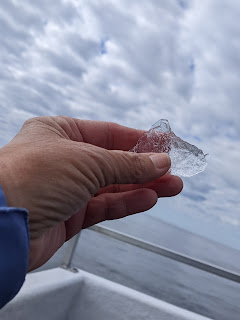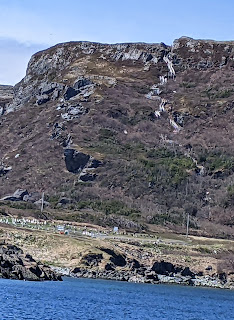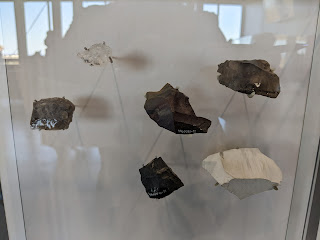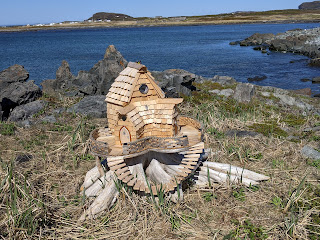
I took this photo shortly after dawn from the deck of our B&B in tiny Gunners Cove on the east coast of Newfoundland's Great Northern Peninsula. Steven and I later headed south toward St. Anthony, the only town and service center for the entire peninsula.
We were looking forward to a boat tour of Iceberg Alley, so called because of the 10,000-year-old icebergs that float in and out of the bay. They originated from glaciers off Greenland and only appear in Newfoundland after two years of travel carried south by the Labrador Current.
Shots of St. Anthony from the boat:
Even before St. Anthony Harbour was named by French explorer Jacques Cartier in 1534, the long, deep, and sheltered harbor was likely well known by fishermen from Brittany, France. The harbor provided Breton fishing ships with the best-sheltered base for fishing in the Straits of Belle Isle between the island of Newfoundland and Labrador.
At the edge of the bay was Fox Point Lighthouse.
Humpback and minke whales had appeared in the harbor in the last few days. Fin whales normally arrive in mid-July.
Further up the coast was St. Anthony Bight known as the "Iceberg Graveyard" because it's where icebergs come to rest in the coves and melt. I either hadn't realized or had forgotten from our trip to Antarctica a few years ago that only one-eighth of icebergs are seen above water and seven-eighths underwater.
We didn't see any whales but everyone on board the boat was happy when an 'enormous' iceberg was spotted pretty far out. The word 'enormous' wasn't simply my description but was the word used by the captain so it really was enormous!
There was no specific name given to the mountain range that came right down to the sea. Look at all the little pieces of ice that had broken off from the giant iceberg.
The biggest iceberg seen in The Alley was back in 2011; it measured a mindboggling 8 miles long by 4 miles wide! It was so 'enormous' that fishing boats had to spend extra time getting around it.
If we'd been here in May, that would have been the lobster season. Now, anglers were on the hunt for tiny shrimp and snow crab.
On the way to see the 'enormous' iceberg, we spotted another iceberg tucked into a cove. Icebergs can travel up to six miles an hour in a fast current but generally move about a mile per day. They're most abundant from April to July.
Did you ever wonder why some
icebergs are white and others have a blue tinge? That's all due to the amount
of oxygen present in the icebergs. The less oxygen there is, the bluer the
iceberg.
This one was estimated to be grounded in 210 feet of water and was 150 feet long. We learned that icebergs are typically 10,000-15,000 years old.
Steven and I just smiled when we were told that this was the biggest iceberg in all of Newfoundland as luck like that just seems to be the norm for us. This incredible sight is what people come to this part of the island to see!
There are generally one or two major fractures per day as the season warms up. These rough edges were due to bits of the iceberg that had fractured off.
I loved how the light changed so dramatically as we made our way around the iceberg. The captain did a remarkable job maneuvering the 48-passenger boat around the iceberg so we could all view it from every angle.
As the temperature warmed up, there would be more and more of these spider cracks in the iceberg.
The captain jokingly referred to this part as the Newfoundland crocodile!
Paul, the boat's owner, went ice fishing for a chunk of the iceberg so we could all see it up close.
He said our lunch that day would be very low in calories - this bergy bit as it was called! We held it up to look for air bubbles in the 10,000-year-old ice.
Paul said a great activity after the ride would be to climb to the top of the mountain outside of St. Anthony. At the base of the mountain was the local cemetery. Evidently, not everyone was successful in ascending the mountain, the captain joked!
As we returned to the harbor, the captain told us there had been so much snow this past April a polar bear even was able to climb atop the roof of the house to the right of the white bus. The resident only knew about it when the bear was caught on a neighbor's camera! Definitely too much snow for us!
The tour had been a rousing success since we'd been all around the mammoth iceberg but whales, puffins, and gannets had all proved elusive.
The coal silos next to the harbor were used to store coal for the Grenfell Mission, a local charity. There used to be a tram and tracks to deliver the coal to the mission and the nearby hospital.
At the harbor was the Dockhouse Museum which started in 1928, was operated by its own coal-fired steam boiler, and pulled vessels of all sizes out of the water for repairs. A sawmill motor located in the dockhouse was needed for ship repairs.
We stopped in across the street from the harbor at the Curtis Memorial Hospital to view murals that were created and fabricated in 1967 by Montreal artist Jordi Bonet. I read that each of the eight murals had meaning relating to the people of Newfoundland and Labrador. It was hard not to be affected immediately by the beauty and harmony as their jewel-like brilliance make the past come to life.
The statue in front of the Grenfell Historic Properties honored Dr. Wilfred Grenfell, a British medical missionary who had arrived in Newfoundland in 1892 to help deep sea fishermen. Seeing the great need for doctors throughout Newfoundland and Labrador, he traveled to medical schools from Ivy League schools beseeching doctors, dentists, and surgeons, to come up for the summer.
Grenfell worked on the coast that was ice-blocked and inaccessible for most of the year to improve the life of the people. Not only did he practice medicine, but he built hospitals, and established schools and orphanages. His mission, the International Grenfell Association, ran from WW I until his death in 1940. It was considered like the Peace Corps of the 1960s!
From the boat, we'd caught a glimpse of this seaplane but it was neat seeing it up close in Memorial Park.
The recommended hike up the mountain was more than we wanted so we took on the far easier Iceberg Alley Trail that followed the tip of the Atlantic Ocean.
A closer view of the Fox Point Lighthouse from Fishing Point:
Views of the mesmerizing coastline:
We walked by the cemetery we'd seen from the boat. The trail up the mountain, aka Daredevil Hill, didn't look as steep here!
The Iceberg Alley Trail led to the Santana Trail which was named after an American who served at the USAF Radio Site in St. Anthony. Santana lost his life saving the lives of two local women off Fishing Point Park.
If we were in St. Anthony at the end of September or the beginning of October, a common sight in these bogs would be people crouching to fill buckets with partridgeberries or bakeapples. The latter are fruit but not apples and look like golden raspberries but taste similar to apricots.
We only saw a mini, mini iceberg off the shore!
Coming across the sea-green water in another cove made us almost think we'd been transported instantly to the warm waters of the Caribbean. Never did we think we might view water this color in Newfoundland!
It was sort of fun having to traipse through the snow to get back to the lighthouse!
After a local man dropped a bottle with a message in it from here at Fishing Point, someone in Brittany found it 544 days later!
The Grenfell House north of town was built in 1910 by local workmen to Grenfell's design. It served as the home for him and his wife initially and later as a staff house and dormitory for the International Grenfell Association. Grenfell's ashes were buried on the hill behind his home.
In St. Anthony's municipal building was a mounted polar bear that wandered into St. Anthony in 1984. Paul, our boat captain, had told us it wasn't unusual for children to stay home from school when there are polar bear sightings.
It was fun walking through the Dark Tickle Shoppe in nearby St. Lunaire which sold jams, preserves, and even chocolates and wines from locally harvested berries.
From St. Anthony, we headed up to the very end of the road and almost the tip of the Great Northern Peninsula to L'Anse aux Meadows which was where the Vikings - the first Europeans - to land in North America came ashore from Greenland about 1,000 years ago.
Newfoundlanders had long been aware of odd-shaped ridges covered by sod in the area but it was only after Norwegian scholars in the 1960s performed archaeological digs that eight complexes of rudimentary houses, workshops with fireplaces, and many artifacts were literally unearthed. It subsequently became a National Historic Site and a UNESCO World Heritage Site in 1978, the first Canadian site to be awarded such status. It took 15 years to excavate the site.
The site was named after the village of the same name to the northeast which may have been a corruption of the French name for Medea's Cove as this was part of the French Shore until 1904. Many French ships in the 1600s and 1700s were named after Medea, the heroine of a tragic Greek play. The Shore, part of the coast of Newfoundland, was where French vessels had been given the right to fish and establish shore stations after France gave up all other claims to the island in 1713.
Flags outside the Visitors' Center represented the provincial flag of Newfoundland and Labrador, Canada, and UNESCO respectively.
One of the artifacts found at the site was this bronze cloak pin.
Chips and other debris from stone tool manufacturers found on the site were long-lasting clues to the past because they didn't decay like wood, bone, and skin. Tools found at L'Anse aux Meadows prove that Indigenous cultures used the site repeatedly for the last 3,000 years, obviously well before the Vikings came.
A reproduction of a Paleoeskimo knife:
But the acidic, waterlogged soil preserved even discarded wood debris from over 3,000 years ago. Wood was essential to the Norse way of life and was the reason for their voyages to this part of Newfoundland.
The cocktail napkins in the gift shop would have been a fun conversation starter as they included Newfoundland sayings!
We headed to the site from what we thought was the unimpressive Visitors' Center visible to the right in the background.
The depression in the ground marked the location of a former sod dwelling.
Some former workshops:
Steven and I have been to famous outdoor sites the world over but never had we seen such poor planning and design as at L'Anse aux Meadows where the descriptions of the sites, i.e. workshop, dwelling, etc, were so far away from the boardwalk where we had to stay.
Having the signs far from the boardwalk was one thing but having them overgrown or obscured by grass was unacceptable.
After a fairly long walk from the visitors' center, we finally reached the re-created turf-walled buildings that served as an over-wintering base for the Vikings.
In what we'd call a small area, we learned that twenty men lived, slept, and ate. Their diet consisted mostly of caribou and whale meat.
Amazingly, four men, likely the leaders, were thought to have slept in two confined spaces like this one.
A lathe for making bowls:
The location of the smoke holes in the roof was just an educated guess but it would have been big enough to allow a man to get through, according to the guide.
One child was born here at the site that they know of. The peat was cut from nearby. Balsam and spruce, both local woods, were used at the site.
Darlene: You'd have felt right at home with this loom!
This guide was phenomenal and an absolute font of information which I appreciated! He mentioned that the Vikings under Leif Eiriksson's leadership arrived about 1,000 years ago on three separate voyages to explore the south via the Gulf of St. Lawrence. He added there was no proof yet that the 60-90 Vikings grew vegetables but archaeologists have continued to look for pollen that would prove vegetables were grown. Likewise, no enclosures for domesticated animals were found that would prove animals were raised. As no burial site was found, it was concluded that bodies were returned home. The only bones found belonged to charred fish species.


I found the entire L'Anse aux Meadows to be of great interest but it was extremely poorly described which was a shame considering it was a UNESCO site. The only employee who volunteered an iota of information was the one outside. I so wanted this to be a great experience as we'd literally driven hundreds of miles out of our way to come to this one spot. It wasn't quite a bust but it sure didn't live up to its billing.
We followed a trail along the coast with no great expectations.
Harry's Cove:
Was it ever a hoot, then, when we came across a succession of intricately decorated gnome houses that we hadn't heard anything about beforehand. Our youngest, Zachary, thought it should have been called Gnomeville!
Your smile for the day - this Dog Library where people were encouraged to take a stick or leave a stick was the first one we'd ever seen!
The water was extraordinarily clear.
More of the iconic Muskoka aka Adirondack chairs that were a common sight in Newfoundland parks:
If there hadn't been signs, we wouldn't have known that there were traces all around us of lifestyles of the past. After the annual seal hunt, skins were soaked here in Skin Pond to loosen the hair. The skins were then tanned and made into waterproof boots, mitts, and other clothing items.
People also came to hunt willow ptarmigan and sea birds, and also trapped and cut hay and wood. In late summer, families searched the bog for bakeapples, blueberries, and blackberries.
The community of L'Anse aux Meadows at the end of the Great Northern Peninsula:
The statue of Leif Eiriksson: "Son of Iceland, Grandson of Norway, and Ancestor of all who emigrated from Nordic lands."
That evening we enjoyed a wonderful dinner at the Norseman Restaurant where we'd made a reservation months previously. Steven ate cod and I had lamb chops as I'm not a fish lover.
We later shared a yummy dessert at the same restaurant we'd eaten at the night before near our B&B. Yes, those were ice cubes from an iceberg that had been 'caught' that day!
I began this post with a sunrise photo from our B&B - here's one from the same spot at sunset.
Next post: The very long drive south and then east to Grand Falls-Windsor near the center of Newfoundland.
Posted on September 12th, 2022, from our home in Denver as we continue to prepare for our upcoming trip to Central America.






















































































































Mother Nature sure does make beautiful ice sculptures!!
ReplyDeleteAin't that the truth!
ReplyDelete